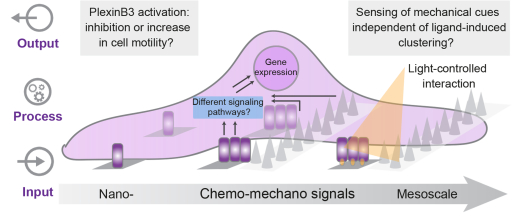Dr. Maria Florencia Sánchez
Decrypting chemo-mechano fingerprints in plexin signaling

Biophysics
Cell biology / Molecular biology
Cell mechanics
Nanotechnology
Receptor signaling
Cells sense their environment, receive, and process a diverse set of chemical and mechanical signals through transmembrane receptors. How receptors sense and integrate these signals to orchestrate a wide variety of physiological outcomes remains one of the biggest questions in biology. Plexins function as receptors for the repulsive axonal guidance molecules semaphorins. Plexins regulate the shape and motility of cells during the development of the nervous and cardiovascular systems, and play important roles in many pathophysiological processes, including cancer, immunological and neurological diseases. However, how the clustering of plexins modulate downstream signaling remain elusive. In particular, there is a lack of connection between receptor cluster size and distribution, mechanical signals, and the impact on the final cellular activity. To bridge this gap, we will develop versatile multidisciplinary approaches to understand critical functions of plexin-semaphorin signaling. My group will use modern techniques ranging from nanolithography, 3D printing, DNA origami, cell and molecular biology and optogenetics to live-cell advanced microscopy. The knowledge and tools designed in this project will go beyond the state-of-the-art and bring unprecedented insights in receptor membrane organization and signaling.

Vita
- 2002-2007 B.Sc. and M.Sc. in Chemistry with Major in Biotechnology, University of Córdoba,
Argentina - 2010-2016 Doctoral researcher, Summa cum laude, Medical Research Institute Mercedes
and Martín Ferreyra, University of Córdoba, Argentina - 2017-present Postdoctoral research fellow. Laboratory of Prof. Dr. Robert Tampé,
Institute of Biochemistry, Goethe University Frankfurt
Selected references
Sánchez MF, Dietz MS, Müller U, Weghuber J, Gatterdam K, Wieneke R, Heilemann M, Lanzerstorfer P, Tampé R. (2022) Dynamic in situ confinement triggers ligand-free neuropeptide receptor signaling. Nano Letters 22: 8363–8371.
Sánchez MF, Tampé R. (2022) Ligand-independent signaling by receptor condensates: a new paradigm. Trends in Biochem Sci 48: 156–171.
Sánchez MF, Els-Heindl S, Beck-Sickinger A-G, Wieneke R, Tampé R. (2021) Photo-induced receptor confinement drives ligand-independent GPCR signaling. Science 371(6536):eabb7657.
Sánchez MF, Murad F, Gülcüler Balta GS, Martin-Villalba A, García-Sáez A-J, Carrer DC. (2018) Early activation of CD95 is limited and localized to the cytotoxic synapse. FEBS J. 285: 2813–2827.
Sánchez MF, Levi V, Weidemann T, Carrer DC. (2015) Agonist mobility in supported bilayers affects Fas mediated death response. FEBS Lett. 589: 3527–3533.
